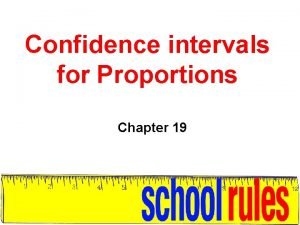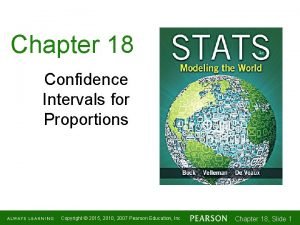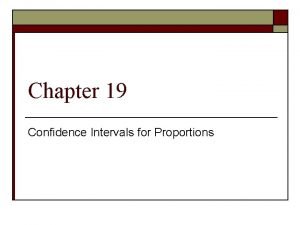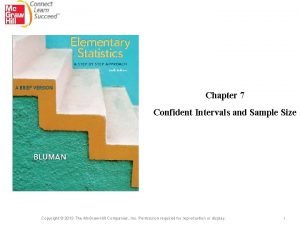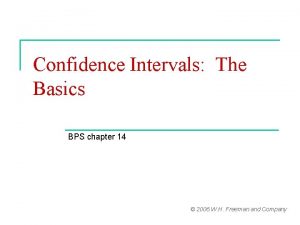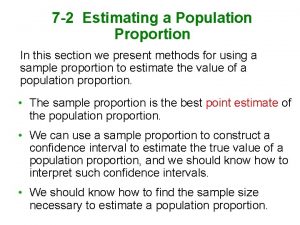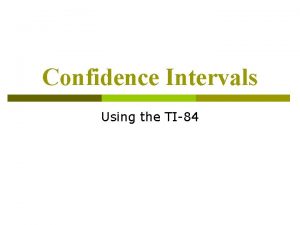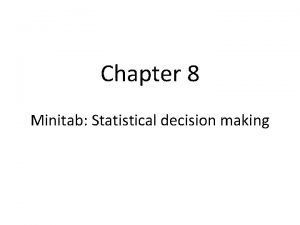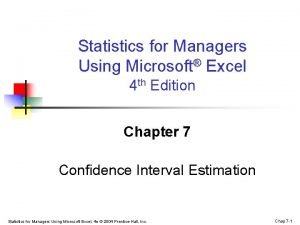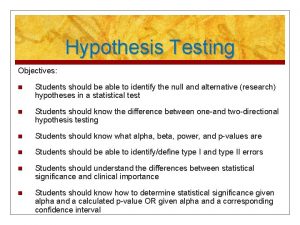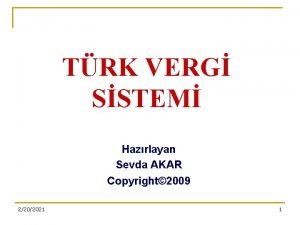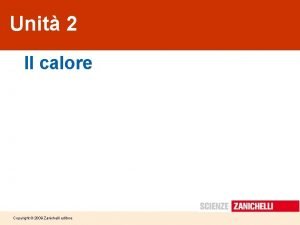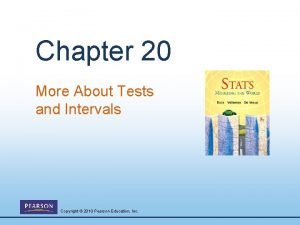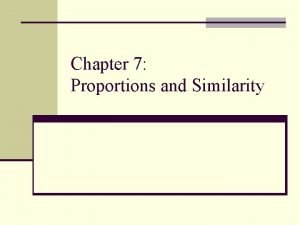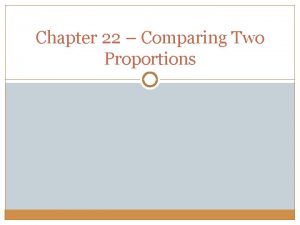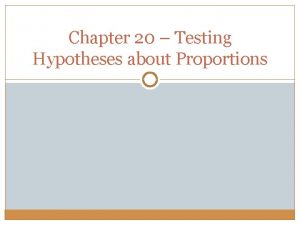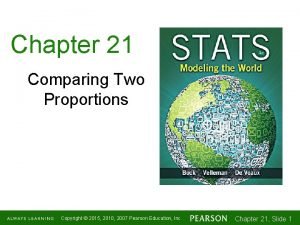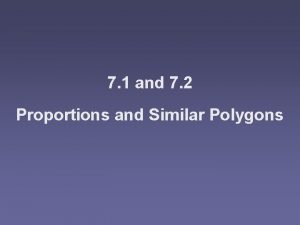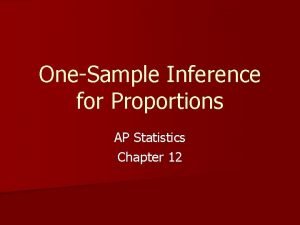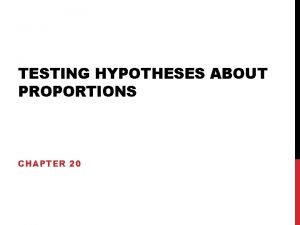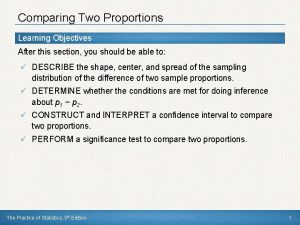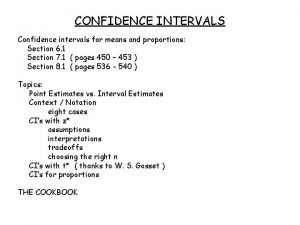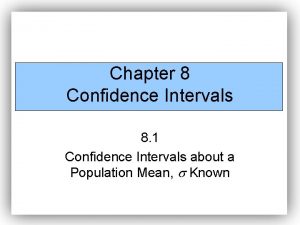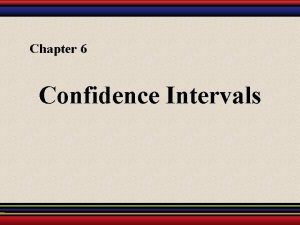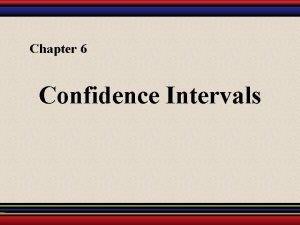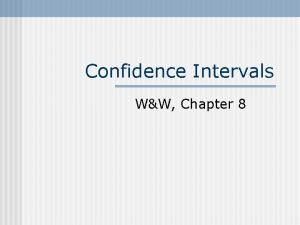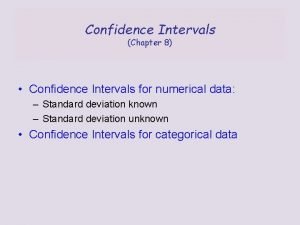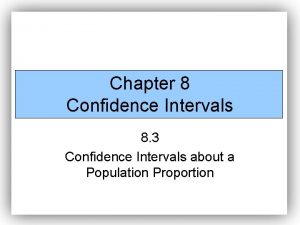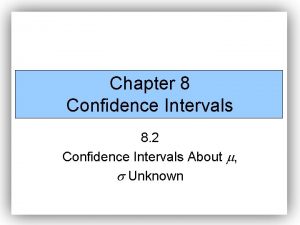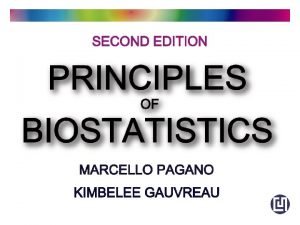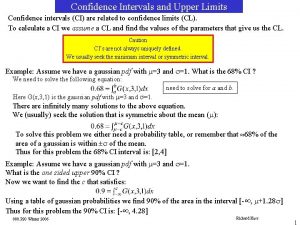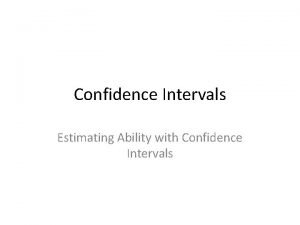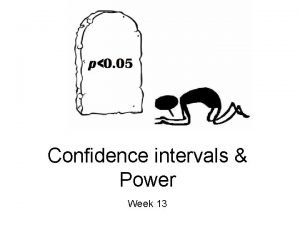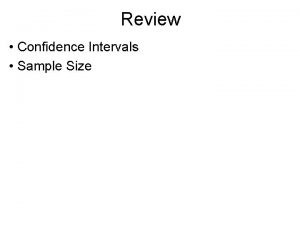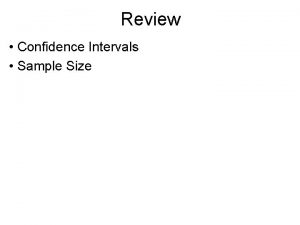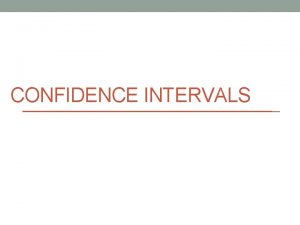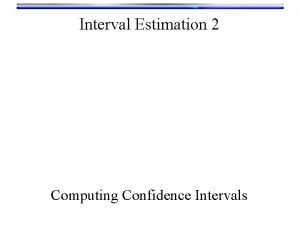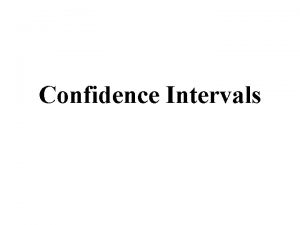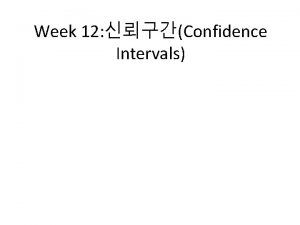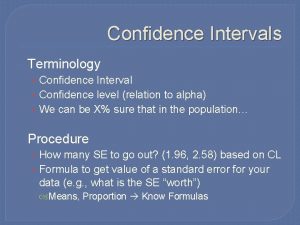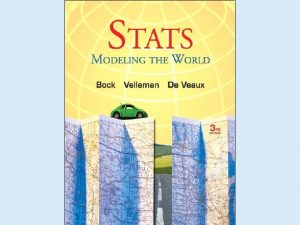Chapter 19 Confidence Intervals for Proportions Copyright 2009










































- Slides: 42

Chapter 19 Confidence Intervals for Proportions Copyright © 2009 Pearson Education, Inc.

Standard Deviation of Sampling Distribution n Both of the sampling distributions we’ve looked at are Normal. n For proportions n For means Copyright © 2009 Pearson Education, Inc. Slide 1 - 2

Standard Error n n n When we don’t know p or σ, we’re stuck, right? Nope. We will use sample statistics to estimate these population parameters. Whenever we estimate the standard deviation of a sampling distribution, we call it a standard error. Copyright © 2009 Pearson Education, Inc. Slide 1 - 3

Standard Error n For a sample proportion, the standard error is n For the sample mean, the standard error is Copyright © 2009 Pearson Education, Inc. Slide 1 - 4

A Confidence Interval n Recall that the sampling distribution model of centered at p, with standard deviation n is. Since we don’t know p, we can’t find the true standard deviation of the sampling distribution model, so we need to find the standard error: Copyright © 2009 Pearson Education, Inc. Slide 1 - 5

A Confidence Interval (cont. ) n n By the 68 -95 -99. 7% Rule, we know n about 68% of all samples will have ’s within 1 SE of p n about 95% of all samples will have ’s within 2 SEs of p n about 99. 7% of all samples will have ’s within 3 SEs of p We can look at this from Copyright © 2009 Pearson Education, Inc. ’s point of view… Slide 1 - 6

A Confidence Interval (cont. ) n n Consider the 95% level: n There’s a 95% chance that p is no more than 2 SEs away from. n So, if we reach out 2 SEs, we are 95% sure that p will be in that interval. In other words, if we reach out 2 SEs in either direction of , we can be 95% confident that this interval contains the true proportion. This is called a 95% confidence interval. Copyright © 2009 Pearson Education, Inc. Slide 1 - 7

A Confidence Interval (cont. ) Copyright © 2009 Pearson Education, Inc. Slide 1 - 8

What Does “ 95% Confidence” Really Mean? n n Each confidence interval uses a sample statistic to estimate a population parameter. But, since samples vary, the statistics we use, and thus the confidence intervals we construct, vary as well. Copyright © 2009 Pearson Education, Inc. Slide 1 - 9

What Does “ 95% Confidence” Really Mean? n The figure to the right shows that some of our confidence intervals (from 20 random samples) capture the true proportion (the green horizontal line), while others do not: Copyright © 2009 Pearson Education, Inc. Slide 1 - 10

What Does “ 95% Confidence” Really Mean? n n Our confidence is in the process of constructing the interval, not in any one interval itself. Thus, we expect 95% of all 95% confidence intervals to contain the true parameter that they are estimating. Copyright © 2009 Pearson Education, Inc. Slide 1 - 11

Margin of Error: Certainty vs. Precision n We can claim, with 95% confidence, that the interval contains the true population proportion. n The extent of the interval on either side of is called the margin of error (ME). In general, confidence intervals have the form estimate ± ME. The more confident we want to be, the larger our ME needs to be (makes the interval wider). Slide 1 - 12 Copyright © 2009 Pearson Education, Inc.

Margin of Error: Certainty vs. Precision Copyright © 2009 Pearson Education, Inc. Slide 1 - 13

Margin of Error: Certainty vs. Precision n To be more confident, we wind up being less precise. n We need more values in our confidence interval to be more certain. Because of this, every confidence interval is a balance between certainty and precision. The tension between certainty and precision is always there. n Fortunately, in most cases we can be both sufficiently certain and sufficiently precise to make useful statements. Copyright © 2009 Pearson Education, Inc. Slide 1 - 14

Margin of Error: Certainty vs. Precision n n The choice of confidence level is somewhat arbitrary, but keep in mind this tension between certainty and precision when selecting your confidence level. The most commonly chosen confidence levels are 90%, 95%, and 99% (but any percentage can be used). Copyright © 2009 Pearson Education, Inc. Slide 1 - 15

Critical Values n n n The ‘ 2’ in (our 95% confidence interval) came from the 68 -95 -99. 7% Rule. Using a table or technology, we find that a more exact value for our 95% confidence interval is 1. 96 instead of 2. n We call 1. 96 the critical value and denote it z*. For any confidence level, we can find the corresponding critical value. Copyright © 2009 Pearson Education, Inc. Slide 1 - 16

Critical Values (cont. ) n Example: For a 90% confidence interval, the critical value is 1. 645: Copyright © 2009 Pearson Education, Inc. Slide 1 - 17

One-Proportion (z) Interval n n When the conditions are met, we are ready to find the confidence interval for the population proportion, p. The confidence interval is where n The critical value, z*, depends on the particular confidence level, C, that you specify. Copyright © 2009 Pearson Education, Inc. Slide 1 - 18

Universal Conditions (Formulas) 1. Randomization Condition: The sample should be a simple random sample of the population. 2. 10% Condition: (Independence) If sampling has not been made with replacement, and you are drawing from a finite population the sample size, n, must be no larger than 10% of the population. (10 n < Pop. Size)

1 -Proportion • Categorical Data • You use p-hat and q-hat to approximate the standard deviation of the population. • Normality Check: The sample size has to be big enough so that both np and n(1 -p) are at least 10.

Steps for Constructing and Interpreting a Confidence Interval 1) 2) 3) 4) 5) 6) State your population (NOT the sample) State the parameter of interest (Mu or p) State the Type of Interval (1 -prop, 1 -samp Z, or 1 -samp t) Check Conditions (If Needed) Show symbols and values and calculate interval on Stat Crunch. Interpret the Interval. Copyright © 2009 Pearson Education, Inc. Slide 1 - 21

Writing your interpretation We are (___)% confident that the (mean or proportion of…. (in context) is somewhere between _____ and ______. Copyright © 2009 Pearson Education, Inc. Slide 1 - 22

Copyright © 2009 Pearson Education, Inc. Slide 1 - 23

Copyright © 2009 Pearson Education, Inc. Slide 1 - 24

Copyright © 2009 Pearson Education, Inc. Slide 1 - 25

Copyright © 2009 Pearson Education, Inc. Slide 1 - 26

Confidence Intervals for a Population Mean (Quantitative) z vs. t distributions • • • z and t distributions Z and t confidence intervals for a population mean Sample size required to estimate

Sample means “Quantitative” z vs. t Z intervals are for when sigma (SD of the population) is known. n T intervals are for when sigma (SD of the population) is unknown and we use “s” (SD of the sample) to approximate sigma. n

1 -Sample Z-test • Quantitative Data • You know (sigma) the standard deviation of the population. • Normality Check: Stated in the question, probability plot, n is at least 30.

1 -Sample t-test • Quantitative Data • You do not know (sigma) the standard deviation of the population. • You use “s” the standard deviation of the sample to approximate sigma. • Normality Check: (Central Limit Theorem) Sample Size of at least 30

Standardize using s for n Substitute s (sample standard deviation) for sssssss s Note quite correct Not knowing means using z is no longer correct

t-distributions Suppose that a Simple Random Sample of size n is drawn from a population whose distribution can be approximated by a N(µ, σ) model. When is known, the sampling model for the mean x is N( , /√n), so is approximately Z~N(0, 1). When is estimated from the sample standard deviation s, the sampling model for follows a t distribution with degrees of freedom n − 1. is the 1 -sample t statistic

Confidence Interval Estimates n CONFIDENCE INTERVAL for n n n n where: t = Critical value from -distribution with n-1 degrees of freedom = Sample mean s = Sample standard deviation n = Sample size t For small samples (n < 30), the data should follow a Normal model very closely. For sample sizes larger than 30, t methods are safe to use.

Student’s t Distribution Z -3 -3 -2 -2 -1 -1 00 11 22 33

Student’s t Distribution Z t -3 -3 -2 -2 -1 -1 00 11 22 33 Figure 11. 3, Page 372

n Example – An investor is trying to estimate the return on investment in companies that won quality awards last year. – A random sample of 41 such companies is selected, and the return on investment is recorded for each company. The data for the 41 companies have – Construct a 95% confidence interval for the mean return.


Example n n n Because cardiac deaths increase after heavy snowfalls, a study was conducted to measure the cardiac demands of shoveling snow by hand The maximum heart rates for 10 adult males were recorded while shoveling snow. The sample mean and sample standard deviation were Assuming the distribution is Normal, find a 90% CI for the population mean max. heart rate for those who shovel snow.

Solution

EXAMPLE: Consumer Protection Agency n n Selected random sample of 16 packages of a product whose packages are marked as weighing 1 pound. From the 16 packages: a. find a 95% CI for the mean weight of the 1 -pound packages n b. should the company’s claim that the mean weight is 1 pound be challenged ? n

EXAMPLE

Choosing type of Interval n n n Categorical Data: 1 -Proportion (Z) Interval *NO SD is ever given Quantitative Data: 1 -Sample Z Interval *used when we know sigma (the SD of the population) Quantitative Data: 1 -Sample T Interval *used when we ONLY know the standard deviation of the sample (s) Copyright © 2009 Pearson Education, Inc. Slide 1 - 42
 Chapter 19 confidence intervals for proportions
Chapter 19 confidence intervals for proportions Chapter 18 confidence intervals for proportions
Chapter 18 confidence intervals for proportions Chapter 19: confidence intervals for proportions
Chapter 19: confidence intervals for proportions Chapter 7 confidence intervals and sample size
Chapter 7 confidence intervals and sample size Importance of confidence interval
Importance of confidence interval 96 confidence interval z score
96 confidence interval z score Reporting confidence intervals
Reporting confidence intervals Is ap stat hard
Is ap stat hard Confidence intervals excel
Confidence intervals excel How to interpret confidence intervals example
How to interpret confidence intervals example Ti 84 confidence interval
Ti 84 confidence interval Confidence interval in minitab
Confidence interval in minitab How to add 95 confidence intervals in excel
How to add 95 confidence intervals in excel Confidence interval vs confidence level
Confidence interval vs confidence level Copyright 2009
Copyright 2009 International color consortium
International color consortium Dell all rights reserved copyright 2009
Dell all rights reserved copyright 2009 Copyright 2009 pearson education inc
Copyright 2009 pearson education inc Diffrazione della luce zanichelli
Diffrazione della luce zanichelli Copyright 2009
Copyright 2009 Calore specifico zanichelli
Calore specifico zanichelli Copyright 2009 pearson education inc
Copyright 2009 pearson education inc Copyright 2009 pearson education inc
Copyright 2009 pearson education inc Copyright 2009 pearson education inc
Copyright 2009 pearson education inc Copyright 2009 pearson education inc
Copyright 2009 pearson education inc Chapter 20 more about tests and intervals
Chapter 20 more about tests and intervals Chapter 7 similarity
Chapter 7 similarity Chapter 22 comparing two proportions
Chapter 22 comparing two proportions Chapter 20 testing hypotheses about proportions
Chapter 20 testing hypotheses about proportions Ap stats chapter 21 comparing two proportions
Ap stats chapter 21 comparing two proportions Chapter 19 testing hypotheses about proportions
Chapter 19 testing hypotheses about proportions 7-2 properties of proportions answers
7-2 properties of proportions answers Chapter 12 inference for proportions answers
Chapter 12 inference for proportions answers Chapter 20 testing hypotheses about proportions
Chapter 20 testing hypotheses about proportions Chapter 22 comparing two proportions
Chapter 22 comparing two proportions Chapter 22 comparing two proportions
Chapter 22 comparing two proportions Chapter 22 comparing two proportions
Chapter 22 comparing two proportions Formuö
Formuö Novell typiska drag
Novell typiska drag Nationell inriktning för artificiell intelligens
Nationell inriktning för artificiell intelligens Vad står k.r.å.k.a.n för
Vad står k.r.å.k.a.n för Varför kallas perioden 1918-1939 för mellankrigstiden?
Varför kallas perioden 1918-1939 för mellankrigstiden? En lathund för arbete med kontinuitetshantering
En lathund för arbete med kontinuitetshantering
